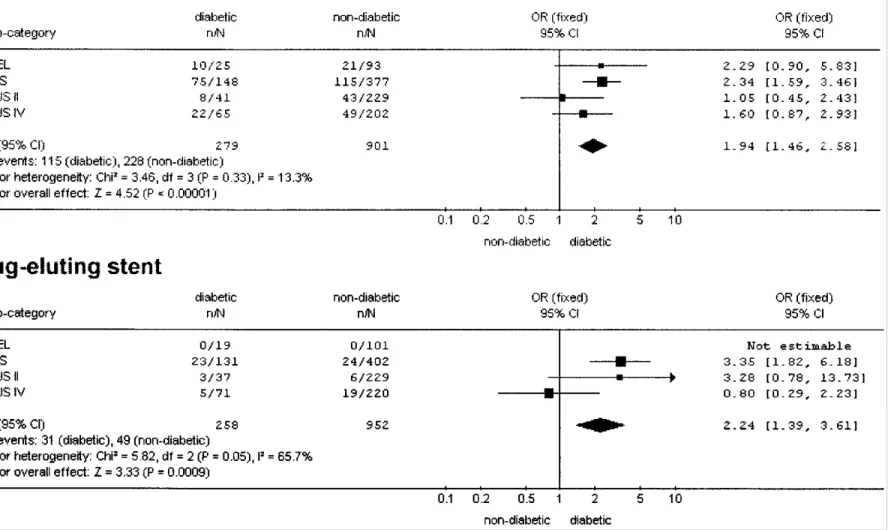Published in: Diabetes Care (2004), vol. 27, iss. 7, pp. 1840-1841 Status: Postprint (Author’s version)
Diabetes Is Still a Risk Factor for Restenosis After Drug-Eluting Stent in
Coronary Arteries
ANDRÉ J. SCHEEN, MD, PHD1FABIAN WARZÉE1
From the 1Divlsion of Diabetes, Nutrition and Metabolic Disorders, Department of Medicine, Centre Hospitalier Universitaire, Sart Tilman, Liège, Belgium.
We read with interest the metaanalysis of the effect of diabetes on restenosis rates among patients receiving coronary angioplasty stenting (1). This meta-analysis of six clinical trials showed that the odds ratio (OR) of coronary artery restenosis associated with diabetes was 1.61 (95% CI 1.21-2.14, P = 0.004) in univariate logistic regression models, but it decreased to 1.30 (0.99-1.70, P = 0.055) after age was controlled in multivariate models. All trials selected in this meta-analysis used classical bare-metal stents. However, drug-eluting stents (DESs) have been shown to improve outcomes among patients undergoing percutaneous coronary intervention by significantly reducing restenosis rates (2).
We performed a meta-analysis of the results from four recently published trials comparing bare-metal stents with DESs, two using sirolimus (RAVEL and SIRIUS) (3, 4) and two using paclitaxel (TAXUS II and TAXUS IV) (5,6) (Fig. 1). These four trials comprised a significant proportion of diabetic patients (~20%) and provided figures that allowed us to recalculate the rate of restenosis after a follow-up of at least 6 months in both the diabetic and nondiabetic populations. The OR of in-stent restenosis in diabetic patients compared with control subjects averaged 1.94 (95% CI 1.46-2.58) in the groups receiving bare-metal stents (P < 0.00001).
Unfortunately, none of the studies gave details about the respective ages of the diabetic and nondiabetic patients, so corrections for possible differences in age were not feasible (1). A similar OR was found when DESs were considered (OR 2.24 [1.39-3.61], P = 0.0009), suggesting that the use of new DESs does not allow to suppress differences between diabetic and nondiabetic patients. In both groups of patients, the rate of restenosis was markedly and significantly (P < 0.00001) higher with bare-metal stents compared with DESs, with an OR of 6.33 (4.57-8.76) in the nondiabetic population and 5.27 (3.36-8.28) in the diabetic population.
These results demonstrated the potential interest of DESs in patients at high risk of restenosis. Nevertheless, even when using DESs, the diabetes status remains a significant risk factor. This was recently confirmed in a large cohort of patients who benefited from unrestricted utilization of sirolimus-eluting stents compared with conventional bare-metal stent implantation in the "real world" (7). This research registry focused on a 1-year cumulative rate of major adverse cardiac events rather than on restenosis. It showed that the benefit of DESs did not reach statistical significance in diabetic patients (OR 0.72 [95% CI 0.30-1.77], P = 0.50). Furthermore, diabetes was a significant predictor of major adverse cardiac events (OR 1.62 [1.09-2.43], P = 0.02) and of clinically driven target vessel revascularization (OR 1.81 [1.10-2.99], P = 0.02) (Fig. 1).
In conclusion, diabetes remains a major risk factor for restenosis after both bare-metal stents and DESs.
Considering the high prevalence and burden of coronary heart disease in diabetic patients, specific studies should be performed in this population in order to test the possibility of reducing the risk of restenosis and major cardiac events, including the use of more effective DESs (2).
Published in: Diabetes Care (2004), vol. 27, iss. 7, pp. 1840-1841 Status: Postprint (Author’s version)
Published in: Diabetes Care (2004), vol. 27, iss. 7, pp. 1840-1841 Status: Postprint (Author’s version)
References
1. Gilbert J, Raboud J, Zinman B: Meta-analysis of the effect of diabetes on restenosis rates among patients receiving coronary angioplasty stenting. Diabetes Care 27: 990-994, 2004
2. Sousa JE, Serruys PW, Costa MA: New frontiers in cardiology: drug-eluting stents (part I & part II). Circulation 107:2274-2279, 2383-2389, 2003
3. Morice M-C, Serruys PW, Sousa JE, Faja-det J, Ban Hayashi E, Perin M, Colombo A, Schuler G, Barragan P, Guagliumi G, Molnar F, Falotico R, for the RAVEL Study Group: A randomized comparison of sirolimus-eluting stent with a standard stent for coronary revascularization. N Engl J Med 346:1773-1780, 2002
4. Moses J, Leon MB, Popma JJ, Fitzgerald PJ, Holmes DR, O'Shaughnessy C, Caputo RP, Kereiakes DJ, Williams DO, Teirstein PS, Jaeger JL, Kuntz RE, for the SIRIUS Investigators: Sirolimus-eluting stents versus standard stents in patients with stenosis in a native coronary artery. N Engl J Med 349:1315-1323, 2003
5. Colombo A, Drzewiecki J, Banning A, Grube E, Hauptmann K, Silber S, Dudek D, Fort S, Schiele F, Zmudka K, Guagliumi G, Russell ME, for the TAXUS II Study Group: Randomized study to assess the effectiveness of slow- and moderate-release polymer-based paclitaxel-eluting stents for coronary artery lesions. Circulation 108:788-794, 2003
6. Stone GW, Ellis SG, Cox DA, Hermiller J, O'Shaughness C, Tift Mann J, Turco M, Caputo R, Bergin P, Greenberg J, Popma JJ, Russell ME, for the TAXUS-IV Investigators: A polymer-based, paclitaxel-eluting stent in patients with coronary artery disease. N Engl ] Med 350: 221-231, 2004
7. Lemos PA, Serruys PW, van Domburg RT, Saia F, Arampatzis CA, Hoye A, Degertekin M, Tanabe K, Daemen J, Liu TKK, McFadden E, Sianos G, Hofma SH, Smits PC, van der Giessen WJ, de Feyter PJ: Unrestricted utilization of sirolimus-eluting stents compared with conventional bare stent implantation in the "Real World": the Rapamycin Eluting Stent Evaluated at Rotterdam Cardiology Hospital (RESEARCH) registry. Circulation 109:190-195, 2004
